Inflation Targeting and its Impact on Economic Principles
VerifiedAdded on 2023/05/29
|11
|1397
|112
AI Summary
This article discusses inflation targeting and its impact on economic principles. It also explores the measures adopted by the UK to avert the negative effects of recessions and compares the inflation targets of Sweden and the UK. The article provides a comprehensive understanding of the topic.
Contribute Materials
Your contribution can guide someone’s learning journey. Share your
documents today.
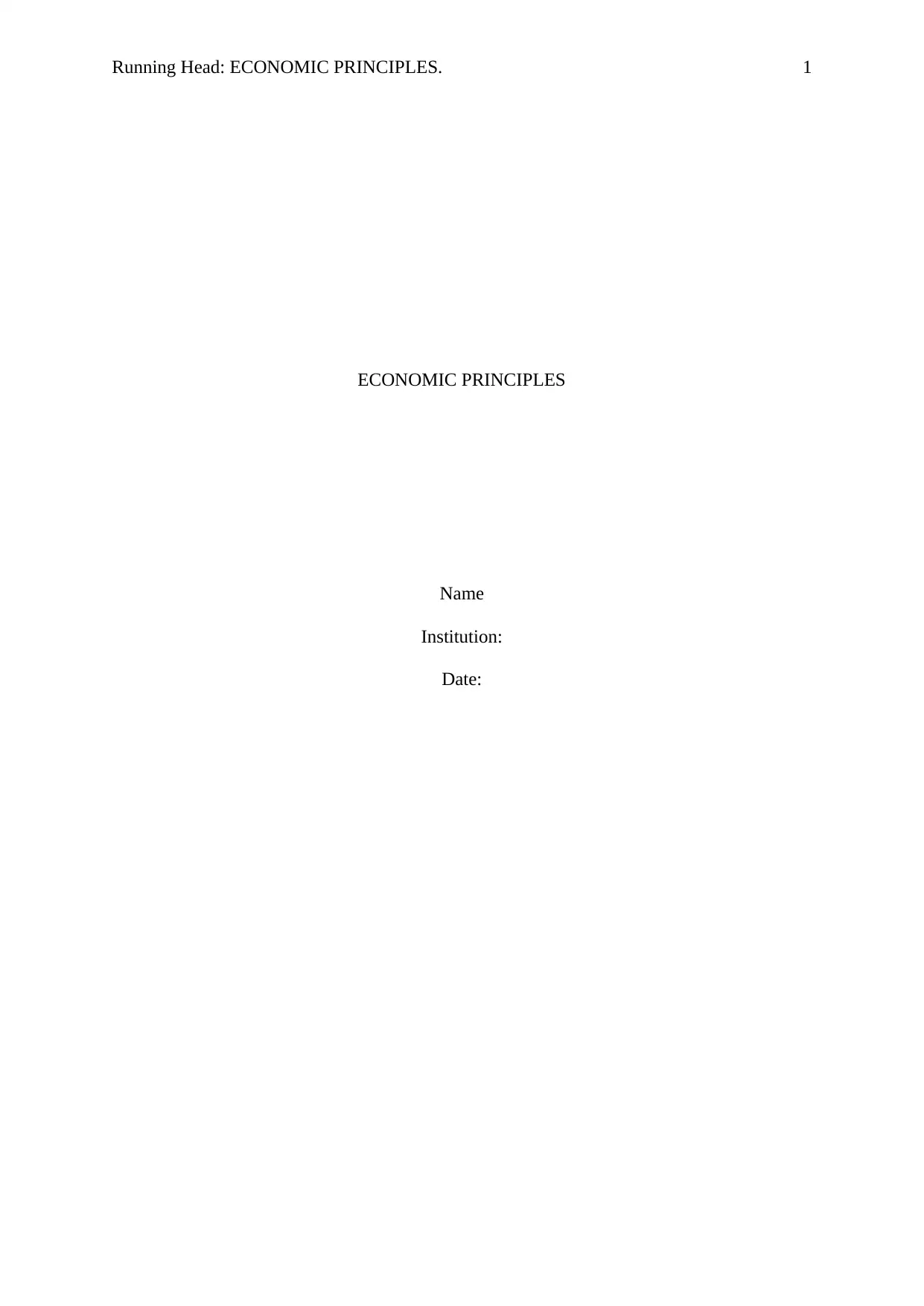
Running Head: ECONOMIC PRINCIPLES. 1
ECONOMIC PRINCIPLES
Name
Institution:
Date:
ECONOMIC PRINCIPLES
Name
Institution:
Date:
Secure Best Marks with AI Grader
Need help grading? Try our AI Grader for instant feedback on your assignments.
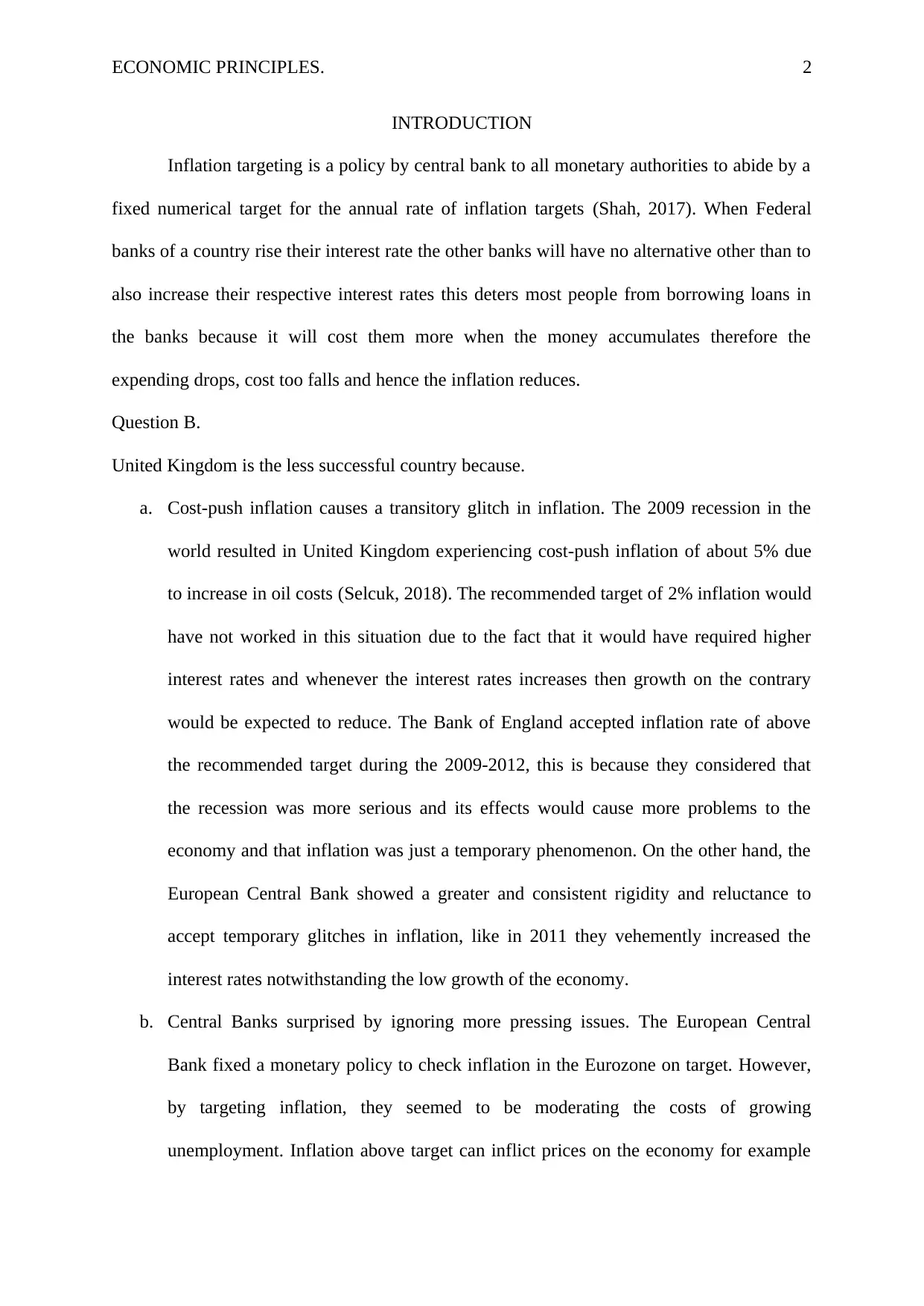
ECONOMIC PRINCIPLES. 2
INTRODUCTION
Inflation targeting is a policy by central bank to all monetary authorities to abide by a
fixed numerical target for the annual rate of inflation targets (Shah, 2017). When Federal
banks of a country rise their interest rate the other banks will have no alternative other than to
also increase their respective interest rates this deters most people from borrowing loans in
the banks because it will cost them more when the money accumulates therefore the
expending drops, cost too falls and hence the inflation reduces.
Question B.
United Kingdom is the less successful country because.
a. Cost-push inflation causes a transitory glitch in inflation. The 2009 recession in the
world resulted in United Kingdom experiencing cost-push inflation of about 5% due
to increase in oil costs (Selcuk, 2018). The recommended target of 2% inflation would
have not worked in this situation due to the fact that it would have required higher
interest rates and whenever the interest rates increases then growth on the contrary
would be expected to reduce. The Bank of England accepted inflation rate of above
the recommended target during the 2009-2012, this is because they considered that
the recession was more serious and its effects would cause more problems to the
economy and that inflation was just a temporary phenomenon. On the other hand, the
European Central Bank showed a greater and consistent rigidity and reluctance to
accept temporary glitches in inflation, like in 2011 they vehemently increased the
interest rates notwithstanding the low growth of the economy.
b. Central Banks surprised by ignoring more pressing issues. The European Central
Bank fixed a monetary policy to check inflation in the Eurozone on target. However,
by targeting inflation, they seemed to be moderating the costs of growing
unemployment. Inflation above target can inflict prices on the economy for example
INTRODUCTION
Inflation targeting is a policy by central bank to all monetary authorities to abide by a
fixed numerical target for the annual rate of inflation targets (Shah, 2017). When Federal
banks of a country rise their interest rate the other banks will have no alternative other than to
also increase their respective interest rates this deters most people from borrowing loans in
the banks because it will cost them more when the money accumulates therefore the
expending drops, cost too falls and hence the inflation reduces.
Question B.
United Kingdom is the less successful country because.
a. Cost-push inflation causes a transitory glitch in inflation. The 2009 recession in the
world resulted in United Kingdom experiencing cost-push inflation of about 5% due
to increase in oil costs (Selcuk, 2018). The recommended target of 2% inflation would
have not worked in this situation due to the fact that it would have required higher
interest rates and whenever the interest rates increases then growth on the contrary
would be expected to reduce. The Bank of England accepted inflation rate of above
the recommended target during the 2009-2012, this is because they considered that
the recession was more serious and its effects would cause more problems to the
economy and that inflation was just a temporary phenomenon. On the other hand, the
European Central Bank showed a greater and consistent rigidity and reluctance to
accept temporary glitches in inflation, like in 2011 they vehemently increased the
interest rates notwithstanding the low growth of the economy.
b. Central Banks surprised by ignoring more pressing issues. The European Central
Bank fixed a monetary policy to check inflation in the Eurozone on target. However,
by targeting inflation, they seemed to be moderating the costs of growing
unemployment. Inflation above target can inflict prices on the economy for example
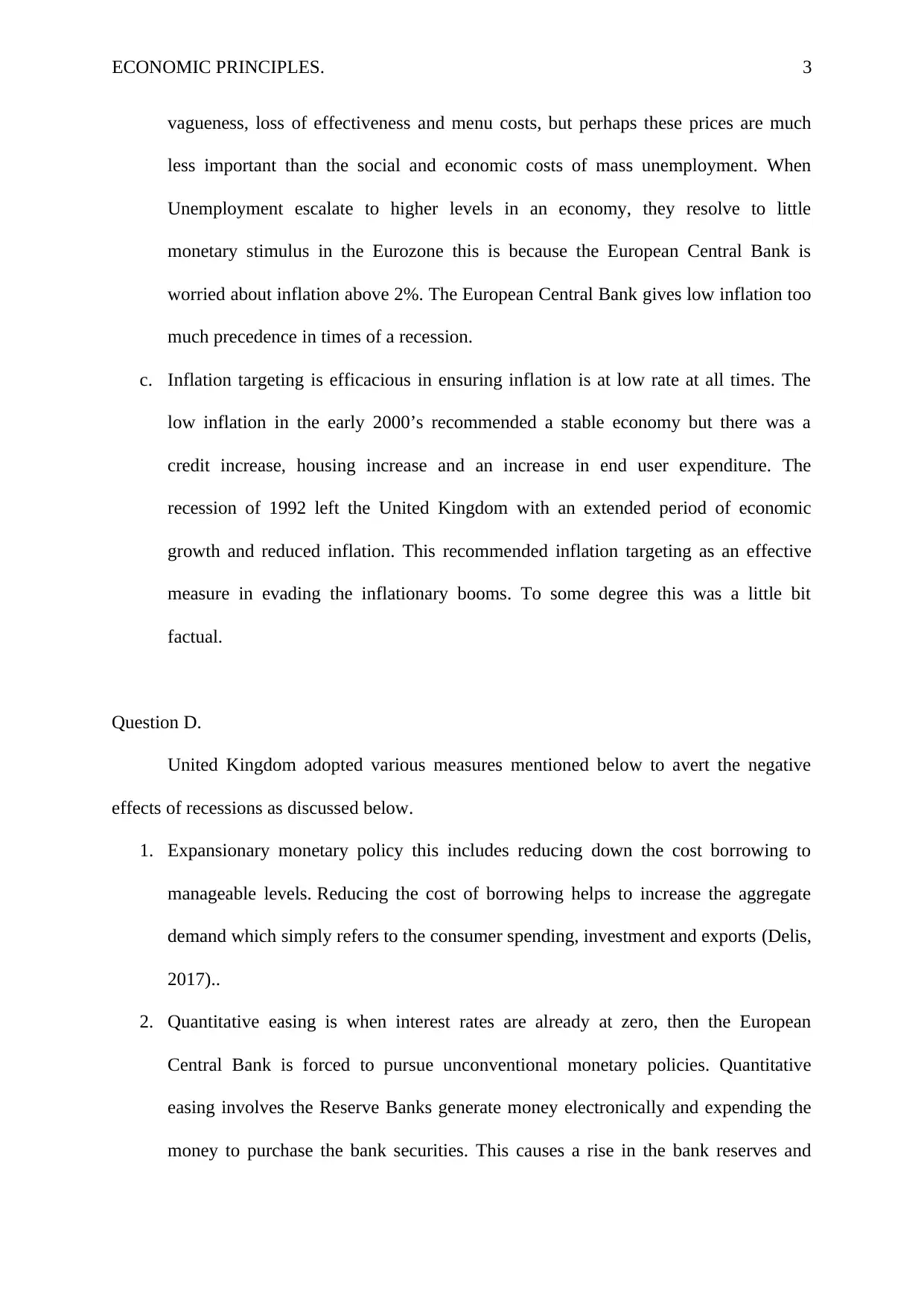
ECONOMIC PRINCIPLES. 3
vagueness, loss of effectiveness and menu costs, but perhaps these prices are much
less important than the social and economic costs of mass unemployment. When
Unemployment escalate to higher levels in an economy, they resolve to little
monetary stimulus in the Eurozone this is because the European Central Bank is
worried about inflation above 2%. The European Central Bank gives low inflation too
much precedence in times of a recession.
c. Inflation targeting is efficacious in ensuring inflation is at low rate at all times. The
low inflation in the early 2000’s recommended a stable economy but there was a
credit increase, housing increase and an increase in end user expenditure. The
recession of 1992 left the United Kingdom with an extended period of economic
growth and reduced inflation. This recommended inflation targeting as an effective
measure in evading the inflationary booms. To some degree this was a little bit
factual.
Question D.
United Kingdom adopted various measures mentioned below to avert the negative
effects of recessions as discussed below.
1. Expansionary monetary policy this includes reducing down the cost borrowing to
manageable levels. Reducing the cost of borrowing helps to increase the aggregate
demand which simply refers to the consumer spending, investment and exports (Delis,
2017)..
2. Quantitative easing is when interest rates are already at zero, then the European
Central Bank is forced to pursue unconventional monetary policies. Quantitative
easing involves the Reserve Banks generate money electronically and expending the
money to purchase the bank securities. This causes a rise in the bank reserves and
vagueness, loss of effectiveness and menu costs, but perhaps these prices are much
less important than the social and economic costs of mass unemployment. When
Unemployment escalate to higher levels in an economy, they resolve to little
monetary stimulus in the Eurozone this is because the European Central Bank is
worried about inflation above 2%. The European Central Bank gives low inflation too
much precedence in times of a recession.
c. Inflation targeting is efficacious in ensuring inflation is at low rate at all times. The
low inflation in the early 2000’s recommended a stable economy but there was a
credit increase, housing increase and an increase in end user expenditure. The
recession of 1992 left the United Kingdom with an extended period of economic
growth and reduced inflation. This recommended inflation targeting as an effective
measure in evading the inflationary booms. To some degree this was a little bit
factual.
Question D.
United Kingdom adopted various measures mentioned below to avert the negative
effects of recessions as discussed below.
1. Expansionary monetary policy this includes reducing down the cost borrowing to
manageable levels. Reducing the cost of borrowing helps to increase the aggregate
demand which simply refers to the consumer spending, investment and exports (Delis,
2017)..
2. Quantitative easing is when interest rates are already at zero, then the European
Central Bank is forced to pursue unconventional monetary policies. Quantitative
easing involves the Reserve Banks generate money electronically and expending the
money to purchase the bank securities. This causes a rise in the bank reserves and
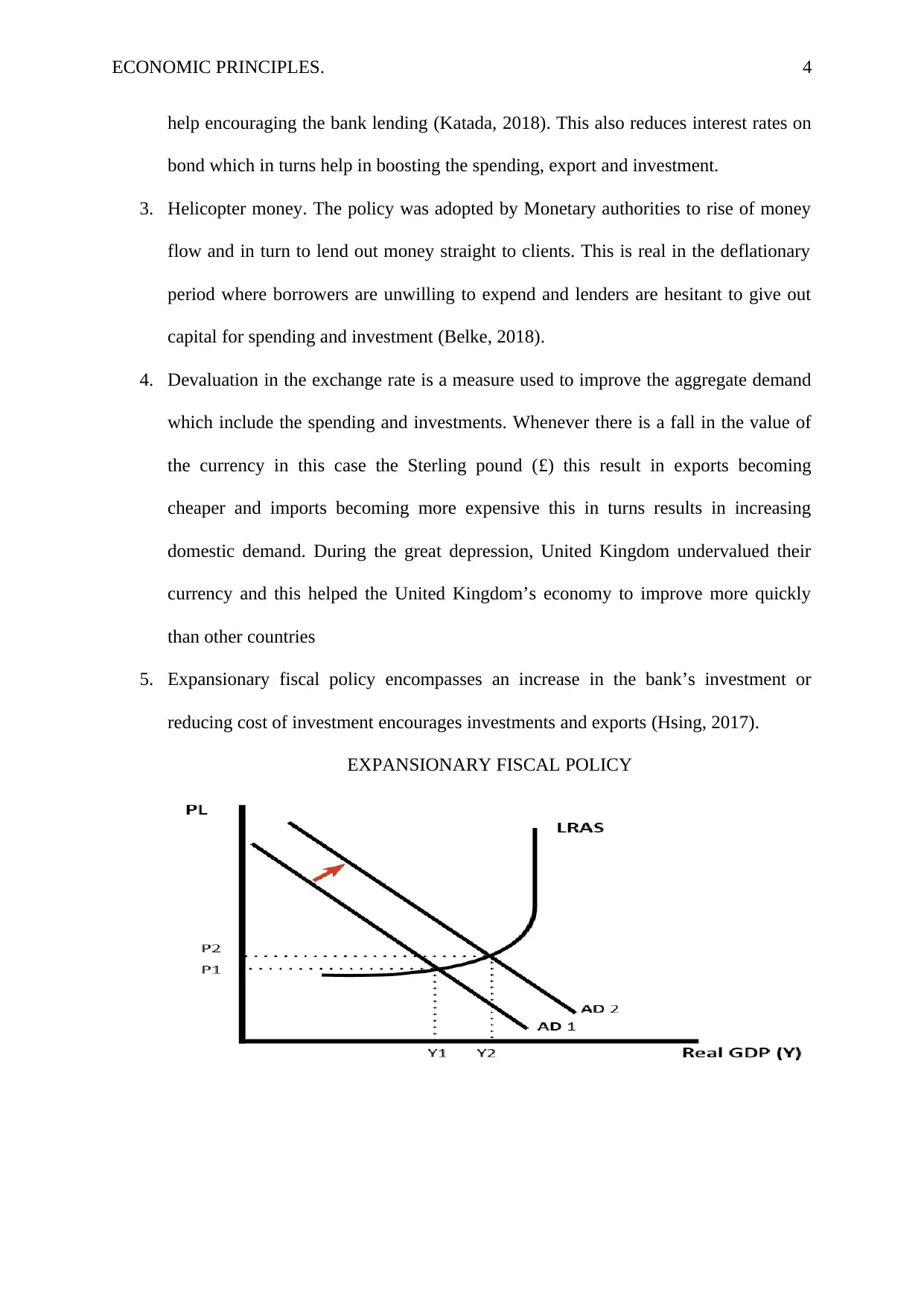
ECONOMIC PRINCIPLES. 4
help encouraging the bank lending (Katada, 2018). This also reduces interest rates on
bond which in turns help in boosting the spending, export and investment.
3. Helicopter money. The policy was adopted by Monetary authorities to rise of money
flow and in turn to lend out money straight to clients. This is real in the deflationary
period where borrowers are unwilling to expend and lenders are hesitant to give out
capital for spending and investment (Belke, 2018).
4. Devaluation in the exchange rate is a measure used to improve the aggregate demand
which include the spending and investments. Whenever there is a fall in the value of
the currency in this case the Sterling pound (£) this result in exports becoming
cheaper and imports becoming more expensive this in turns results in increasing
domestic demand. During the great depression, United Kingdom undervalued their
currency and this helped the United Kingdom’s economy to improve more quickly
than other countries
5. Expansionary fiscal policy encompasses an increase in the bank’s investment or
reducing cost of investment encourages investments and exports (Hsing, 2017).
EXPANSIONARY FISCAL POLICY
help encouraging the bank lending (Katada, 2018). This also reduces interest rates on
bond which in turns help in boosting the spending, export and investment.
3. Helicopter money. The policy was adopted by Monetary authorities to rise of money
flow and in turn to lend out money straight to clients. This is real in the deflationary
period where borrowers are unwilling to expend and lenders are hesitant to give out
capital for spending and investment (Belke, 2018).
4. Devaluation in the exchange rate is a measure used to improve the aggregate demand
which include the spending and investments. Whenever there is a fall in the value of
the currency in this case the Sterling pound (£) this result in exports becoming
cheaper and imports becoming more expensive this in turns results in increasing
domestic demand. During the great depression, United Kingdom undervalued their
currency and this helped the United Kingdom’s economy to improve more quickly
than other countries
5. Expansionary fiscal policy encompasses an increase in the bank’s investment or
reducing cost of investment encourages investments and exports (Hsing, 2017).
EXPANSIONARY FISCAL POLICY
Secure Best Marks with AI Grader
Need help grading? Try our AI Grader for instant feedback on your assignments.
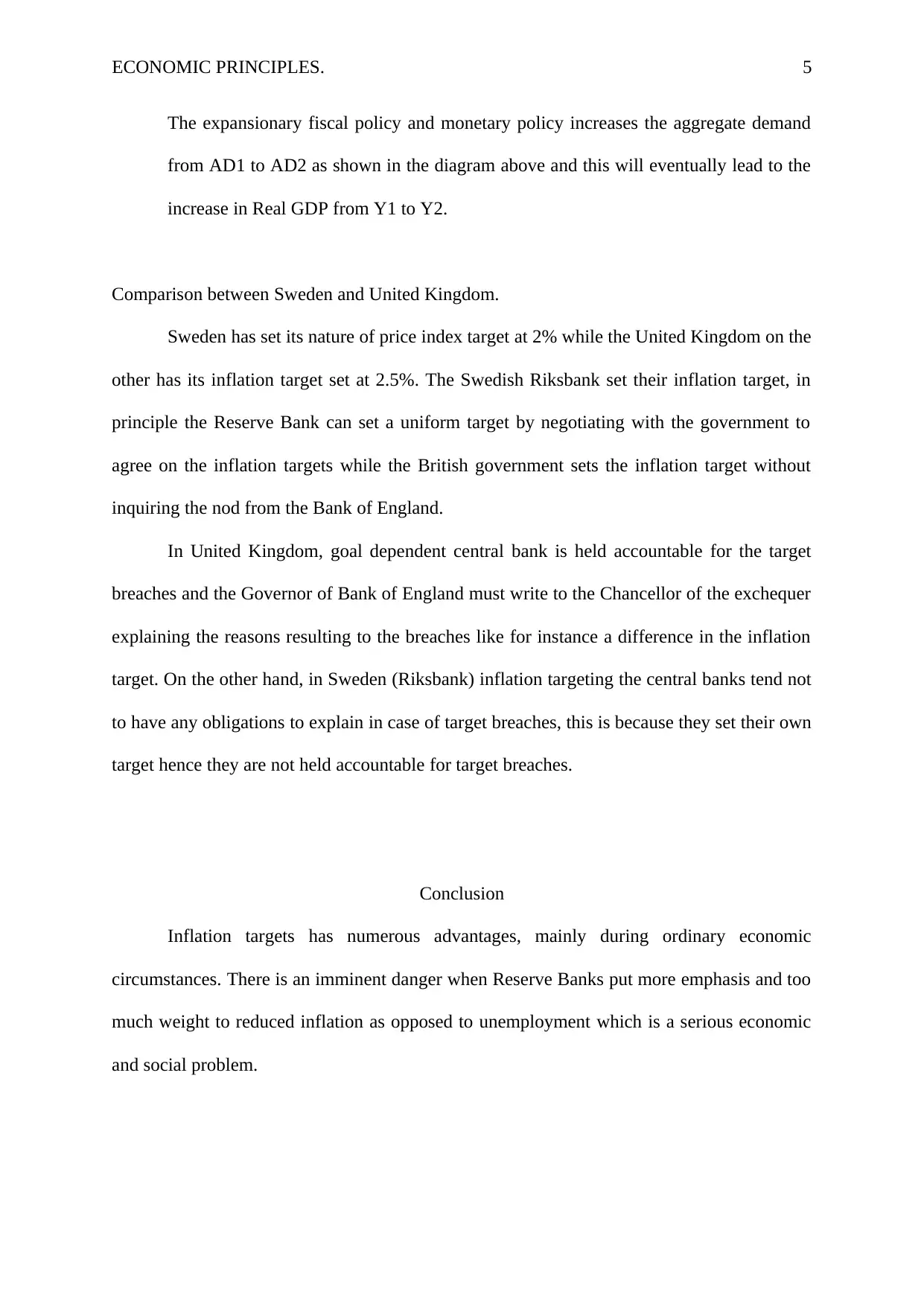
ECONOMIC PRINCIPLES. 5
The expansionary fiscal policy and monetary policy increases the aggregate demand
from AD1 to AD2 as shown in the diagram above and this will eventually lead to the
increase in Real GDP from Y1 to Y2.
Comparison between Sweden and United Kingdom.
Sweden has set its nature of price index target at 2% while the United Kingdom on the
other has its inflation target set at 2.5%. The Swedish Riksbank set their inflation target, in
principle the Reserve Bank can set a uniform target by negotiating with the government to
agree on the inflation targets while the British government sets the inflation target without
inquiring the nod from the Bank of England.
In United Kingdom, goal dependent central bank is held accountable for the target
breaches and the Governor of Bank of England must write to the Chancellor of the exchequer
explaining the reasons resulting to the breaches like for instance a difference in the inflation
target. On the other hand, in Sweden (Riksbank) inflation targeting the central banks tend not
to have any obligations to explain in case of target breaches, this is because they set their own
target hence they are not held accountable for target breaches.
Conclusion
Inflation targets has numerous advantages, mainly during ordinary economic
circumstances. There is an imminent danger when Reserve Banks put more emphasis and too
much weight to reduced inflation as opposed to unemployment which is a serious economic
and social problem.
The expansionary fiscal policy and monetary policy increases the aggregate demand
from AD1 to AD2 as shown in the diagram above and this will eventually lead to the
increase in Real GDP from Y1 to Y2.
Comparison between Sweden and United Kingdom.
Sweden has set its nature of price index target at 2% while the United Kingdom on the
other has its inflation target set at 2.5%. The Swedish Riksbank set their inflation target, in
principle the Reserve Bank can set a uniform target by negotiating with the government to
agree on the inflation targets while the British government sets the inflation target without
inquiring the nod from the Bank of England.
In United Kingdom, goal dependent central bank is held accountable for the target
breaches and the Governor of Bank of England must write to the Chancellor of the exchequer
explaining the reasons resulting to the breaches like for instance a difference in the inflation
target. On the other hand, in Sweden (Riksbank) inflation targeting the central banks tend not
to have any obligations to explain in case of target breaches, this is because they set their own
target hence they are not held accountable for target breaches.
Conclusion
Inflation targets has numerous advantages, mainly during ordinary economic
circumstances. There is an imminent danger when Reserve Banks put more emphasis and too
much weight to reduced inflation as opposed to unemployment which is a serious economic
and social problem.
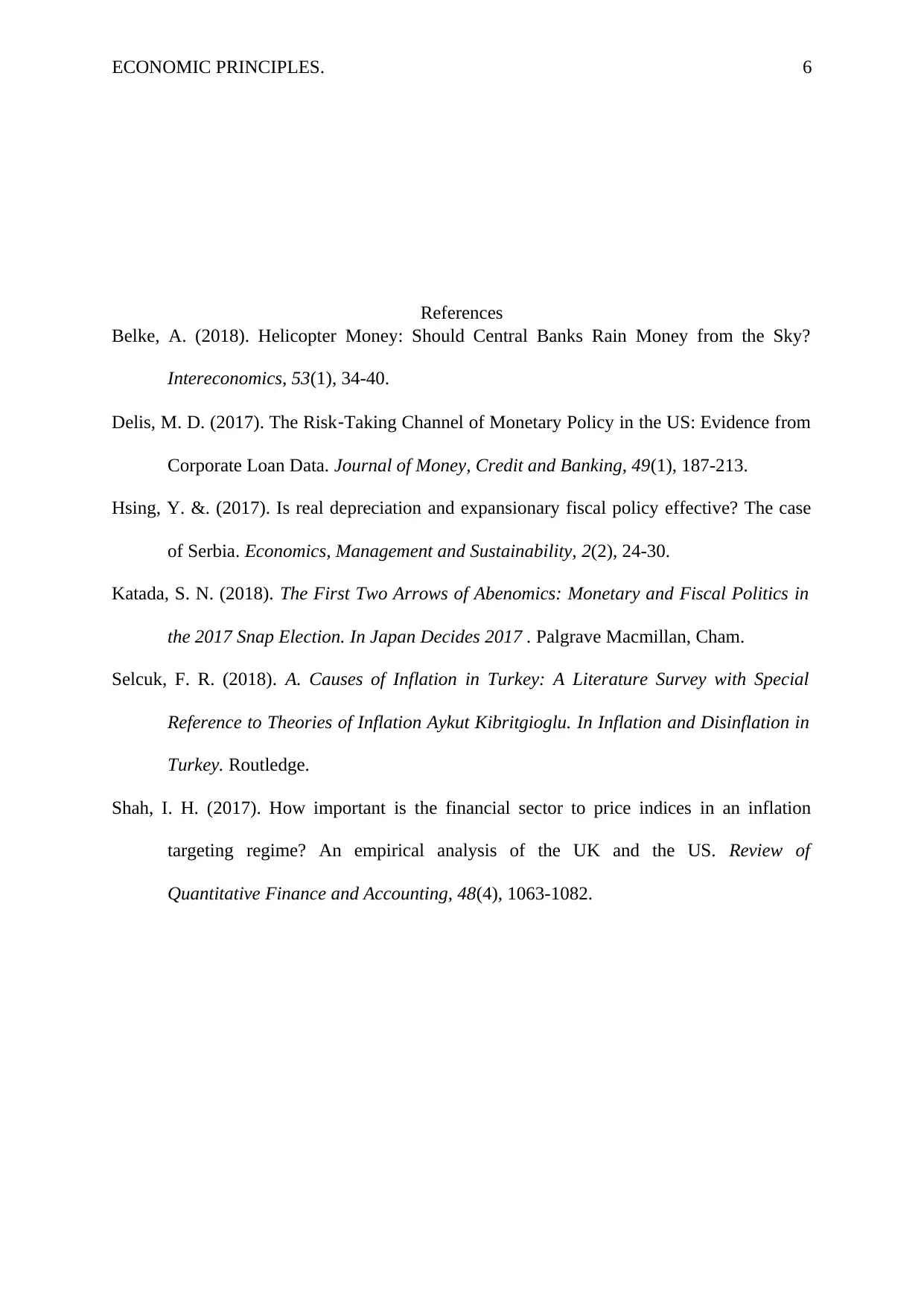
ECONOMIC PRINCIPLES. 6
References
Belke, A. (2018). Helicopter Money: Should Central Banks Rain Money from the Sky?
Intereconomics, 53(1), 34-40.
Delis, M. D. (2017). The Risk‐Taking Channel of Monetary Policy in the US: Evidence from
Corporate Loan Data. Journal of Money, Credit and Banking, 49(1), 187-213.
Hsing, Y. &. (2017). Is real depreciation and expansionary fiscal policy effective? The case
of Serbia. Economics, Management and Sustainability, 2(2), 24-30.
Katada, S. N. (2018). The First Two Arrows of Abenomics: Monetary and Fiscal Politics in
the 2017 Snap Election. In Japan Decides 2017 . Palgrave Macmillan, Cham.
Selcuk, F. R. (2018). A. Causes of Inflation in Turkey: A Literature Survey with Special
Reference to Theories of Inflation Aykut Kibritgioglu. In Inflation and Disinflation in
Turkey. Routledge.
Shah, I. H. (2017). How important is the financial sector to price indices in an inflation
targeting regime? An empirical analysis of the UK and the US. Review of
Quantitative Finance and Accounting, 48(4), 1063-1082.
References
Belke, A. (2018). Helicopter Money: Should Central Banks Rain Money from the Sky?
Intereconomics, 53(1), 34-40.
Delis, M. D. (2017). The Risk‐Taking Channel of Monetary Policy in the US: Evidence from
Corporate Loan Data. Journal of Money, Credit and Banking, 49(1), 187-213.
Hsing, Y. &. (2017). Is real depreciation and expansionary fiscal policy effective? The case
of Serbia. Economics, Management and Sustainability, 2(2), 24-30.
Katada, S. N. (2018). The First Two Arrows of Abenomics: Monetary and Fiscal Politics in
the 2017 Snap Election. In Japan Decides 2017 . Palgrave Macmillan, Cham.
Selcuk, F. R. (2018). A. Causes of Inflation in Turkey: A Literature Survey with Special
Reference to Theories of Inflation Aykut Kibritgioglu. In Inflation and Disinflation in
Turkey. Routledge.
Shah, I. H. (2017). How important is the financial sector to price indices in an inflation
targeting regime? An empirical analysis of the UK and the US. Review of
Quantitative Finance and Accounting, 48(4), 1063-1082.
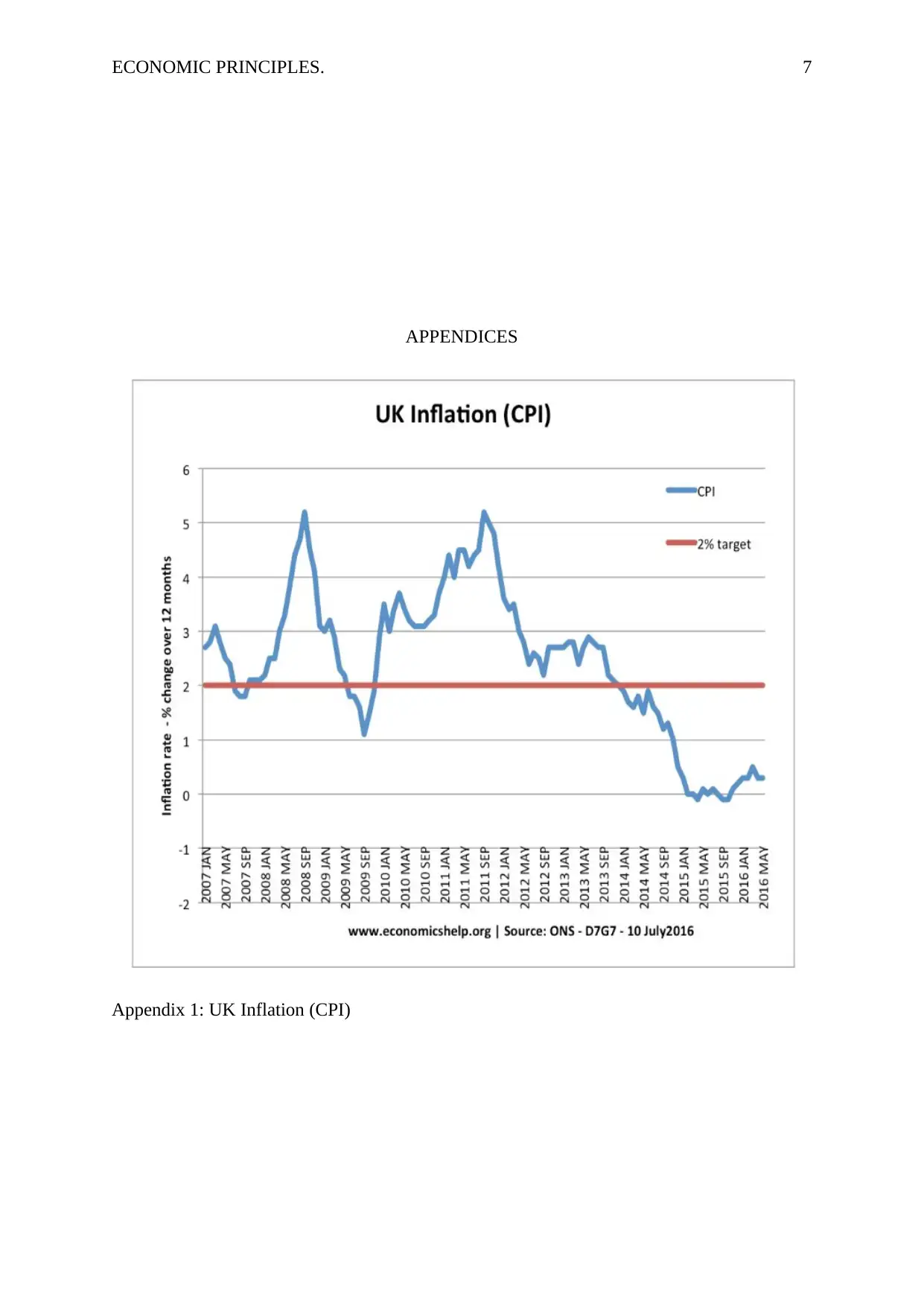
ECONOMIC PRINCIPLES. 7
APPENDICES
Appendix 1: UK Inflation (CPI)
APPENDICES
Appendix 1: UK Inflation (CPI)
Paraphrase This Document
Need a fresh take? Get an instant paraphrase of this document with our AI Paraphraser
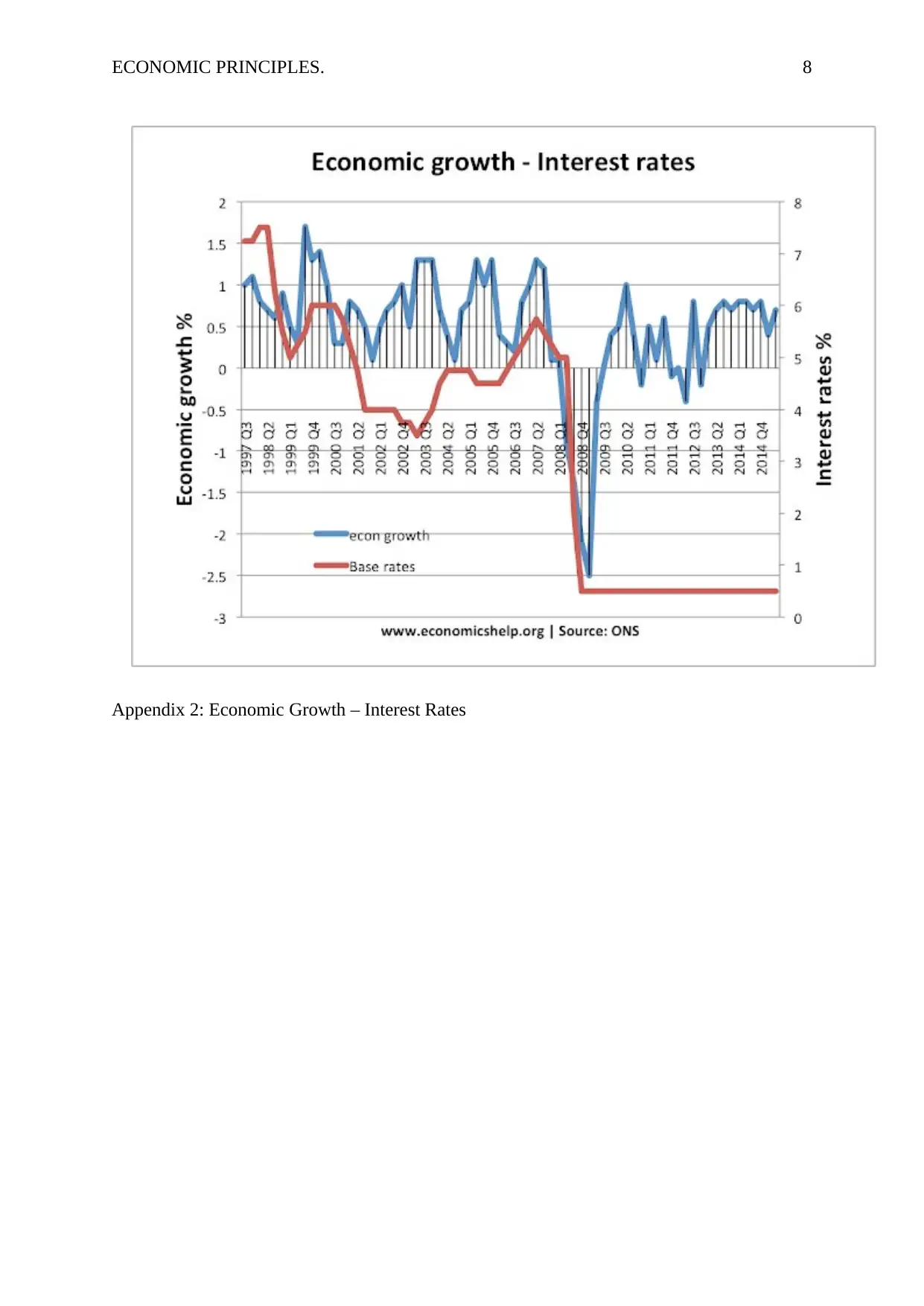
ECONOMIC PRINCIPLES. 8
Appendix 2: Economic Growth – Interest Rates
Appendix 2: Economic Growth – Interest Rates

ECONOMIC PRINCIPLES. 9
aa
aa
aaa
aa
aa
aaa
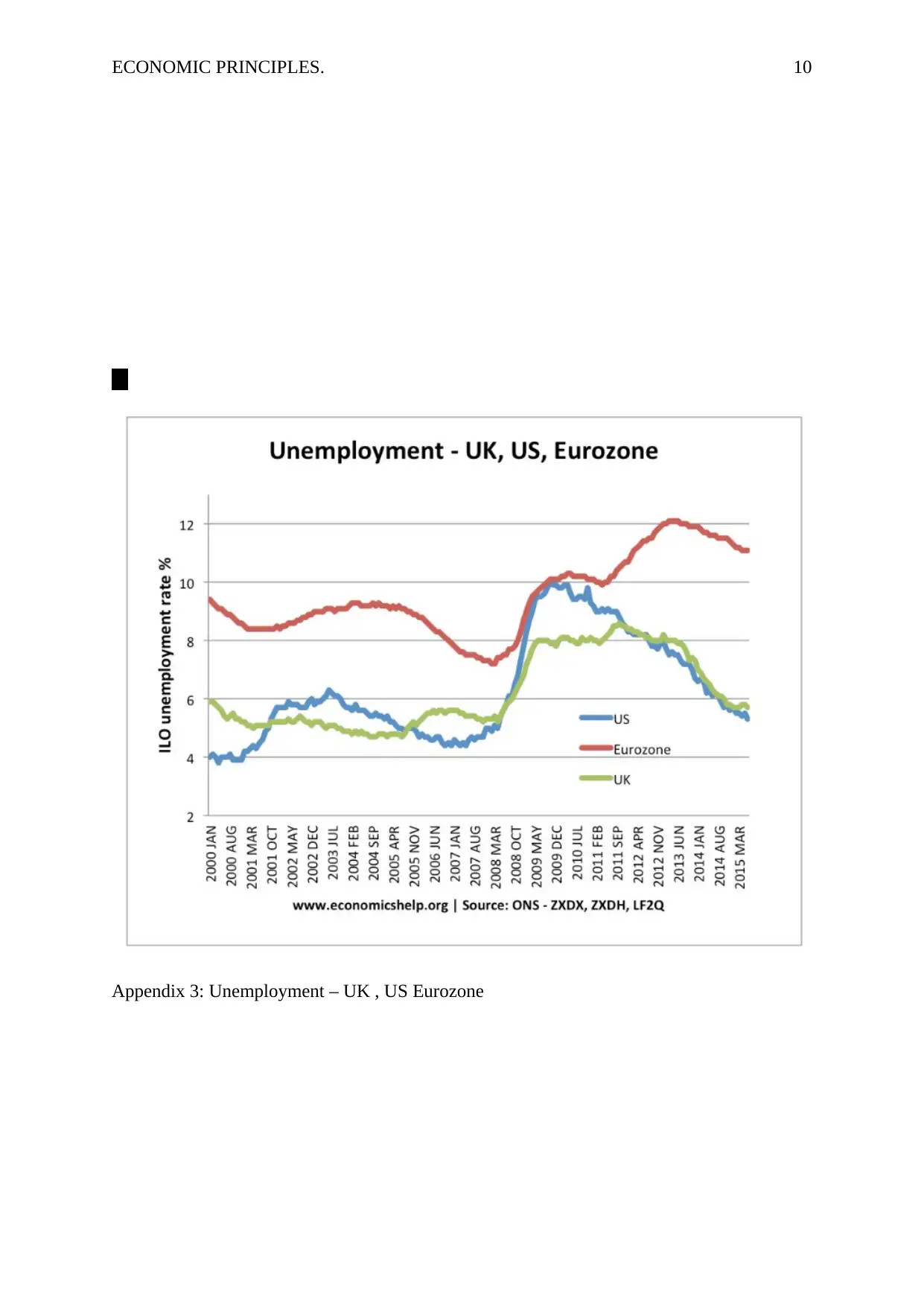
ECONOMIC PRINCIPLES. 10
aa
Appendix 3: Unemployment – UK , US Eurozone
aa
Appendix 3: Unemployment – UK , US Eurozone
Secure Best Marks with AI Grader
Need help grading? Try our AI Grader for instant feedback on your assignments.
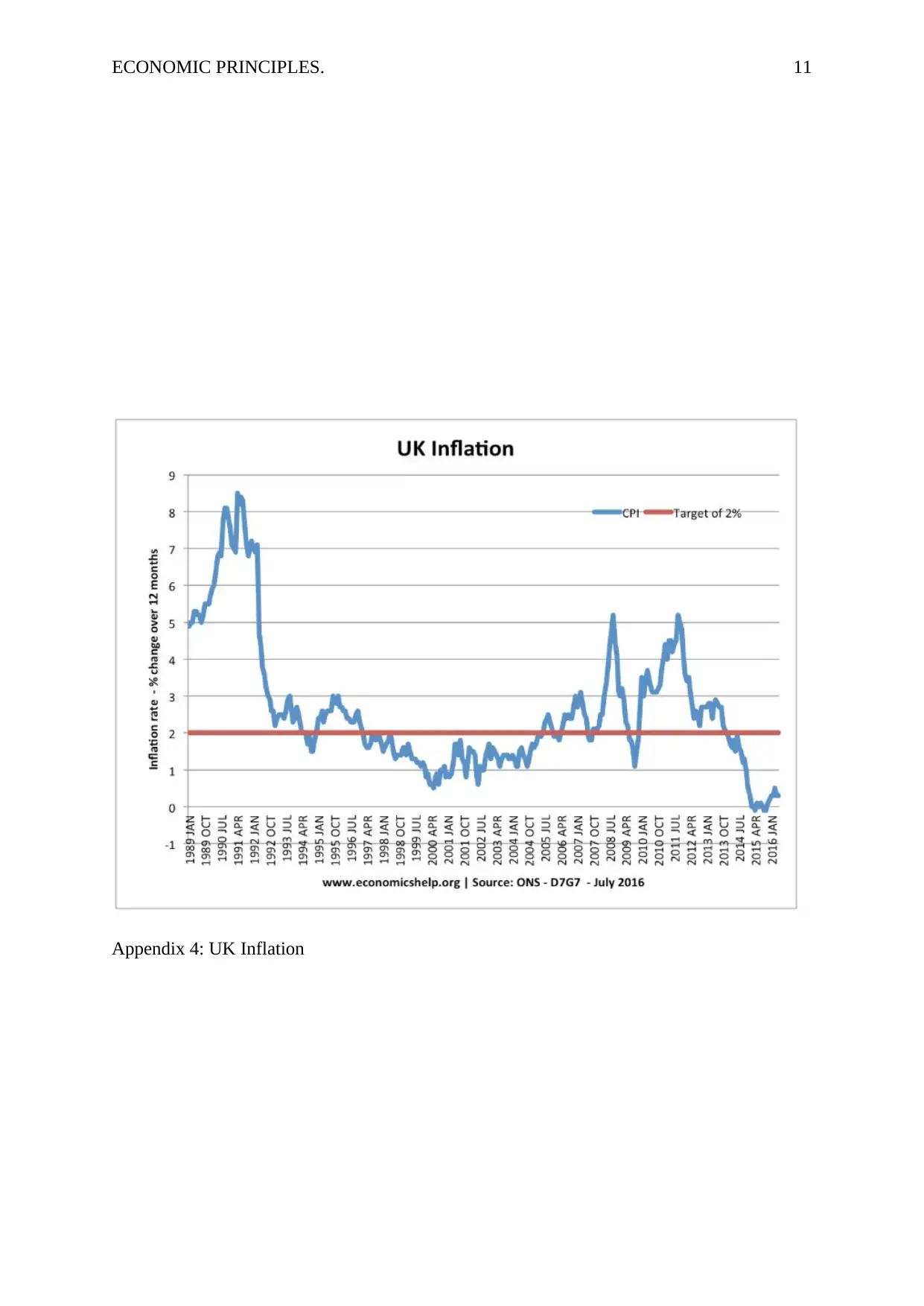
ECONOMIC PRINCIPLES. 11
Appendix 4: UK Inflation
Appendix 4: UK Inflation
1 out of 11
Related Documents
Your All-in-One AI-Powered Toolkit for Academic Success.
+13062052269
info@desklib.com
Available 24*7 on WhatsApp / Email
![[object Object]](/_next/static/media/star-bottom.7253800d.svg)
Unlock your academic potential
© 2024 | Zucol Services PVT LTD | All rights reserved.





